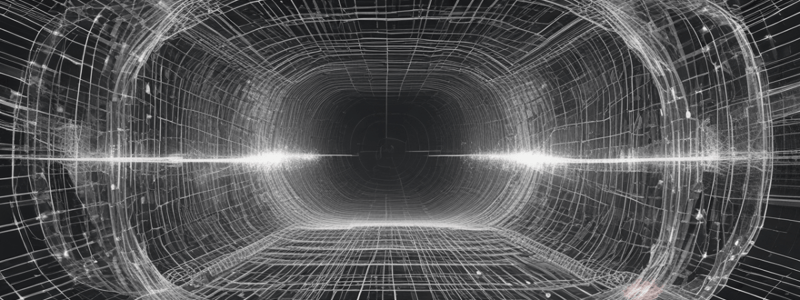Podcast
Questions and Answers
What is the primary function of a computational graph in machine learning?
What is the primary function of a computational graph in machine learning?
A computational graph serves to represent computations and their dependencies visually, which aids in performing operations like backpropagation efficiently.
Describe the forward pass in the context of backpropagation.
Describe the forward pass in the context of backpropagation.
In the forward pass, input data is propagated through the model to make predictions, leading to an output value based on current weights.
What does the reverse pass in backpropagation accomplish?
What does the reverse pass in backpropagation accomplish?
The reverse pass computes the gradients of the loss function with respect to each weight by propagating the error backwards through the network.
How does gradient descent relate to the process of backpropagation?
How does gradient descent relate to the process of backpropagation?
Explain the role of the chain rule in backpropagation.
Explain the role of the chain rule in backpropagation.
What is the importance of measuring output error in a backpropagation process?
What is the importance of measuring output error in a backpropagation process?
Describe how weights are adjusted after computing gradients.
Describe how weights are adjusted after computing gradients.
Identify what is typically represented by the nodes in a computational graph.
Identify what is typically represented by the nodes in a computational graph.
What happens if the learning rate in gradient descent is too high?
What happens if the learning rate in gradient descent is too high?
How are hidden layers represented in a computational graph?
How are hidden layers represented in a computational graph?
How does the derivative of the loss function relate to the weights in a deep network?
How does the derivative of the loss function relate to the weights in a deep network?
What is the role of the derivative of the activation function in backpropagation?
What is the role of the derivative of the activation function in backpropagation?
Explain the significance of the vanishing gradient problem in deep networks.
Explain the significance of the vanishing gradient problem in deep networks.
What does the sum of the derivatives from neurons in the next layer represent for a hidden unit?
What does the sum of the derivatives from neurons in the next layer represent for a hidden unit?
In a simple deep neural network with 5 layers and a single neuron per layer, what happens during error propagation?
In a simple deep neural network with 5 layers and a single neuron per layer, what happens during error propagation?
Why is it necessary for layer weights to be adjusted in relation to their contributions to the next layer?
Why is it necessary for layer weights to be adjusted in relation to their contributions to the next layer?
What impact does a network's depth have on the derivatives of the loss during training?
What impact does a network's depth have on the derivatives of the loss during training?
In context to the given figure, what does 𝜕L/𝜕h represent?
In context to the given figure, what does 𝜕L/𝜕h represent?
Discuss how adjusting weights in Layer i affects Layer i+1 in backpropagation.
Discuss how adjusting weights in Layer i affects Layer i+1 in backpropagation.
What is the relationship between layer depth and learning efficiency?
What is the relationship between layer depth and learning efficiency?
Flashcards are hidden until you start studying
Study Notes
Computational Graphs and Backpropagation
- Computational graphs represent mathematical functions as a directed graph, showing the structure of the computation performed.
- Backpropagation involves a systematic method to compute gradients used in updating model parameters.
Forward Pass
- For each input sample, make predictions by propagating unit values from the input layer to the output layer.
- Model output is calculated with the expression
out = model(x).
Loss Measurement
- Calculate the output error by evaluating the loss function, comparing model output against the target.
Reverse Pass
- Derive error contributions from each layer by propagating gradients backward through the network.
- Gradients are computed as derivatives of the loss with respect to each weight.
Weight Updates
- Perform weight updates in the direction of the negative gradient to minimize output error, using gradient descent.
Chain Rule of Calculus
- Essential for calculating derivatives during backpropagation.
- Allows decomposition of complex derivatives into simpler parts.
Neuron Gradient Descent
- Loss derivative is determined by weights and activation functions affecting neuron outputs.
- Each weight update incorporates derivatives of both loss and activation functions.
Deep Network Dynamics
- In multi-layer networks, each hidden unit's error gradient is the sum of contributions from subsequent layers.
- Functionally, every layer’s neurons contribute to calculations in the layer above, necessitating summation of gradients to determine effective updates.
Vanishing Gradient Problem
- In deep networks, gradients can become very small, leading to ineffective learning.
- Example scenario includes a deep network with five layers and a single neuron per layer, where error propagation may weaken significantly.
Why Theory Matters
- Understanding gradient calculations is vital for effectively training deep neural networks.
- Proper handling of gradients directly impacts the model performance and convergence during training.
Studying That Suits You
Use AI to generate personalized quizzes and flashcards to suit your learning preferences.




